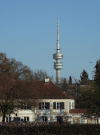
Olympiaturm (Olympia Tower). (802k)
From the Munich entry in Wikipedia:
Munich is the capital and most populous city of the German state of Bavaria. With a population of 1,558,395 inhabitants as of 31 July 2020, it is the third-largest city in Germany, after Berlin and Hamburg, and thus the largest which does not constitute its own state, as well as the 11th-largest city in the European Union. The city's metropolitan region is home to 6 million people. Straddling the banks of the River Isar (a tributary of the Danube) north of the Bavarian Alps, Munich is the seat of the Bavarian administrative region of Upper Bavaria, while being the most densely populated municipality in Germany (4,500 people per km²). Munich is the second-largest city in the Bavarian dialect area, after the Austrian capital of Vienna.
The city was first mentioned in 1158. Catholic Munich strongly resisted the Reformation and was a political point of divergence during the resulting Thirty Years' War, but remained physically untouched despite an occupation by the Protestant Swedes. Once Bavaria was established as a sovereign kingdom in 1806, Munich became a major European center of arts, architecture, culture and science. In 1918, during the German Revolution, the ruling house of Wittelsbach, which had governed Bavaria since 1180, was forced to abdicate in Munich and a short-lived socialist republic was declared. In the 1920s, Munich became home to several political factions, among them the NSDAP. After the Nazis' rise to power, Munich was declared their "Capital of the Movement". The city was heavily bombed during World War II, but has restored most of its traditional cityscape. After the end of postwar American occupation in 1949, there was a great increase in population and economic power during the years of Wirtschaftswunder, or "economic miracle". The city hosted the 1972 Summer Olympics and was one of the host cities of the 1974 and 2006 FIFA World Cups.
Today, Munich is a global center of art, science, technology, finance, publishing, culture, innovation, education, business, and tourism and enjoys a very high standard and quality of living, reaching first in Germany and third worldwide according to the 2018 Mercer survey, and being rated the world's most livable city by the Monocle's Quality of Life Survey 2018. Munich is consistently ranked as one of the most expensive cities in Germany in terms of real estate prices and rental costs. According to the Globalization and World Rankings Research Institute, Munich is considered an alpha-world city, as of 2015. It is one of the most prosperous and fastest growing cities in Germany. The city is home to more than 530,000 people of foreign background, making up 37.7% of its population.
All pictures are © Dr. Günther Eichhorn, unless otherwise noted.

















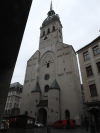

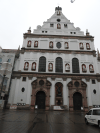


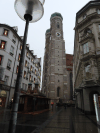

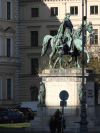



From the Nymphenburg Palace entry in Wikipedia:
The Nymphenburg Palace (German: Schloss Nymphenburg, Palace of the Nymphs) is a Baroque palace situated in Munich's western district Neuhausen-Nymphenburg, in Bavaria, southern Germany. Combined with the adjacent Nymphenburg Palace Park it constitutes one of the premier royal palaces of Europe. Its frontal width of 632 m (2,073 ft) (north–south axis) even surpasses Versailles Palace. The Nymphenburg served as the main summer residence for the former rulers of Bavaria of the House of Wittelsbach.
The palace was commissioned by the electoral couple Ferdinand Maria and Henriette Adelaide of Savoy to the designs of the Italian architect Agostino Barelli in 1664 after the birth of their son Maximilian II Emanuel. The central pavilion was completed in 1675. As a building material, it utilized limestone from Kelheim. The palace was gradually expanded and transformed over the years. It then quickly replaced the nearby Blutenburg Castle as major hunting lodge of the court and competed to Schleissheim Palace.
Starting in 1701, Maximilian Emanuel, the heir to Bavaria, a sovereign electorate of the Holy Roman Empire, undertook a systematic extension of the palace. Two pavilions were added each in the south and north of Barelli's palace by Enrico Zucalli and Giovanni Antonio Viscardi and were connected with the center pavilion by two gallery wings. In 1716, Joseph Effner redesigned the facade of the center pavilion in French Baroque style with pilasters. Later, the south section of the palace was further extended to build the court stables (1719). For the sake of balance, the orangery building was added to the north which was only completed in 1758. Finally, Nymphenburg Palace was completed with a grand circle (the Schlossrondell) of Baroque mansions (the so-called Kavaliershäuschen – cavalier's lodges) erected under Maximilian Emanuel's son Holy Roman Emperor Charles VII Albert.
In 1795, Charles Theodore, Elector of Bavaria ordered the widening of the galleries on the park side. In 1826, under King Ludwig I of Bavaria, his architect Leo von Klenze removed the gables of the main pavilion with the Electoral coat of arms and created an attic style decoration directly under the roof instead.












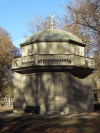



This page contains 44 pictures

Main page for Deutschland (Germany)
Page last updated on Sat Jan 7 18:20:43 2023 (Mountain Standard Time)
München on guenther-eichhorn.com